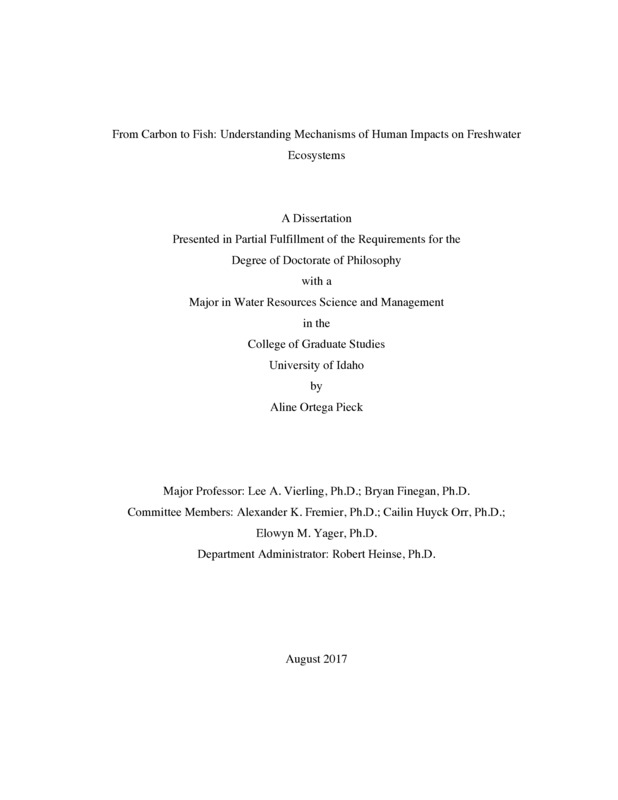From Carbon to Fish: Understanding Mechanisms of Human Impacts on Freshwater Ecosystems
Ortega Pieck, Aline. (2017-08). From Carbon to Fish: Understanding Mechanisms of Human Impacts on Freshwater Ecosystems. Theses and Dissertations Collection, University of Idaho Library Digital Collections. https://www.lib.uidaho.edu/digital/etd/items/ortegapieck_idaho_0089e_11202.html
- Title:
- From Carbon to Fish: Understanding Mechanisms of Human Impacts on Freshwater Ecosystems
- Author:
- Ortega Pieck, Aline
- ORCID:
- 0000-0001-5371-4240
- Date:
- 2017-08
- Embargo Remove Date:
- 2019-09-05
- Keywords:
- African fisheries Gross primary production Land-use change Meta-analysis Riparian vegetation Stream metabolism
- Program:
- Water Resources
- Subject Category:
- Ecology; Environmental management; Biogeochemistry
- Abstract:
-
Freshwater ecosystems provide essential ecosystem services (e.g. clean water, food production) to society. These services are impacted by human activities, such as agriculture. A critical change resulting from agricultural land use is the alteration of stream organic carbon processing (stream metabolism). Carbon is the building block of all organisms and represents the energy base fueling ecosystems. Streams also play a key role in the global carbon cycle. Thus, understanding how agriculture modifies metabolism is relevant at scales ranging from local (e.g. stream ecosystem assessments) to global (e.g. modeling carbon exports from streams).
Most of our knowledge on stream metabolism derives from temperate latitudes. Metabolic drivers in tropical regions have unique regimes that could lead to particular responses to agriculture, yet we have limited empirical evidence of the magnitude of metabolism in these regions. At larger scales, it is unknown whether metabolic responses to agriculture differ between world biomes or agricultural types. Thus, Chapter 1 presents an empirical study of stream metabolism in a humid-tropical watershed. I specifically ask, what is the magnitude of metabolism in streams draining abrupt forest-agricultural boundaries? Which factors drive metabolic changes? Results show that metabolism increases with higher light in agricultural areas but metabolic rates are generally low in areas adjacent to forests. Chapter 2 is a global meta-analysis where I ask, does stream metabolism in biomes with contrasting types of riparian vegetation respond differently to agriculture? Does metabolism differ between croplands and pastures? Results show that biome light regimes determine metabolic vulnerability and that metabolism differs between croplands and pastures. Chapter 3 is an interdisciplinary modelling effort of fish yields in small reservoirs in semi-arid Africa. Fisheries are essential for population nutrition and resilience but we lack tools to estimate yields at large spatial scales. I present a method paring remotely-sensed water dynamics with an empirical equation of fish yield that can be used to understand small reservoir fisheries across semi-arid landscapes.
This dissertation furthers our understanding of human influences of on freshwater ecosystems. This knowledge may be used to better manage trade-offs between agriculture production and freshwater ecosystem services.
- Description:
- doctoral, Ph.D., Water Resources -- University of Idaho - College of Graduate Studies, 2017-08
- Major Professor:
- Vierling, Lee A; Finegan, Bryan
- Committee:
- Fremier, Alexander K; Orr, Cailin Huyck; Yager, Elowyn M
- Defense Date:
- 2017-08
- Identifier:
- OrtegaPieck_idaho_0089E_11202
- Type:
- Text
- Format Original:
- Format:
- application/pdf
- Rights:
- In Copyright - Educational Use Permitted. For more information, please contact University of Idaho Library Special Collections and Archives Department at libspec@uidaho.edu.
- Standardized Rights:
- http://rightsstatements.org/vocab/InC-EDU/1.0/

